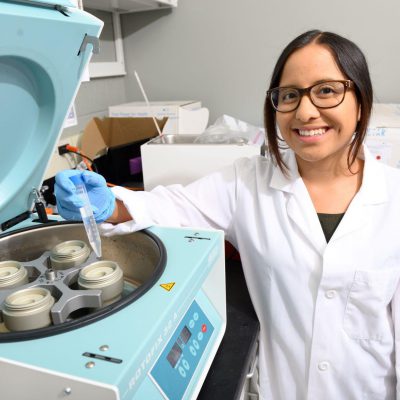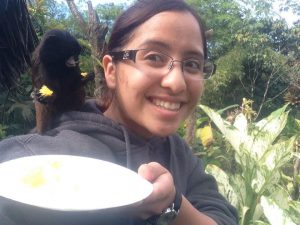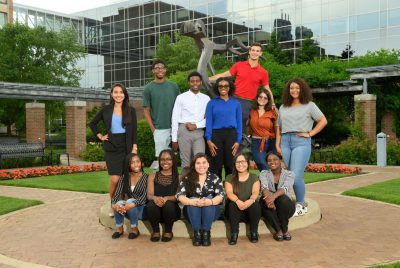by Kimberly Guzman

“There is nothing else that can be done.” After witnessing my kitty, Mishi, suffer from hyperthyroidism and bringing her to the vet, those are words I wish I never had to hear. I wish the vet could have said: “There is a new treatment option for Mishi!”
Hello, my name is Kimberly Guzman and I am a Rutgers University ’17 Alumni from Belleville, New Jersey, who will be pursuing a Doctor of Veterinary Medicine (DVM) degree this fall at Michigan State University’s College of Veterinary Medicine.
I have always been passionate about pursuing a career that included helping animals and humans live harmoniously. My family has taken in kitties, dogs, birds, hamsters, mice, an iguana—you name it. Growing up, my mom took us to the Central Park Zoo and the American Museum of Natural History in New York City, where I would question what I could do to help people respect and learn to care for animals. We also lived in Ecuador for a few years, and I remember watching stray dogs begging for food outside restaurants as I walked the streets of Cuenca and thinking: How can I help?
I am pursuing veterinary medicine because I would like to become a veterinary researcher and clinician that can offer a beloved pet and their owner a new diagnostic option or new pain management treatment. I would like to be able to say: “The new treatment options are…”

A couple days after being accepted to the DVM Program and learning that my dream to become a veterinarian was going to come true, I received an email from Dr. Susan Ewart, inviting me to apply to the Biomedical Research for University Students in the Health Sciences (BRUSH) Undergraduate Summer Research Program. I immediately applied and received the chance to conduct funded, hypothesis-driven research under the guidance of a faculty mentor at MSU.
I was a bit nervous at first, moving so far from home, but was very excited for the journey to come. The experience was one I will never forget. I met a lot of research students from different states. We not only obtained the opportunity to perform cutting edge research at the same East Lansing campus, but we lived in the same dorm, ate at the Brody dining hall every day, and would be there for each other if anyone needed to go buy groceries or talk about their day.
We even had time to enjoy weekend trips to Lake Michigan, Chicago, and Canada. By the end of the program, I gained exciting research experiences, made lifelong best friends, and was able to learn about the MSU campus prior to beginning veterinary school.
There were many research topics to choose from: the role food additives play in food allergies, antibiotic resistance in cows, the role of immune cells in the lungs, and more. I chose to work with Dr. Cheryl Rockwell and Dr. Yining Jin in the Pharmacology and Toxicology Department. Our research topic was about specific food additives and whether they exacerbate an allergic response in the immune system. I enjoyed reviewing food allergy and food additive literature. I learned to count cells under a microscope, draw blood samples from mice, run ELISA (enzyme-linked immunosorbent assay) tests to determine their antibody levels, isolate splenocytes to then count immune cells, etc.

I also learned about the Institutional Animal Care and Use Committee (IACUC) and the strict regulations put in place to make sure lab animals are held in compliance with standards and regulatory requirements. My favorite part of my research experience was knowing that our research could be part of a future treatment that could help thousands of people and animals suffering from food allergies.
Presenting my food allergy research at the Boehringer Ingelheim NIH Veterinary Scholars Symposium in Massachusetts and meeting veterinary students from all over the United States, and even other countries, was an opportunity I am glad to have been part of. As a scientist, it is of utmost importance to be able to explain your research. The symposium taught me that there is veterinary research going on everywhere and that the opportunities are endless.
I look forward starting the DVM Program and learning the “whys” behind all my questions, such as how specific treatments work and what further diagnostics are available. I am excited to learn that I can bring a smile to someone’s face when I discuss the multiple treatment plans available to help lessen an animal’s suffering, something I wish I could have had when I took Mishi to the vet. I am very excited to dive in and continue learning what veterinary medicine has to offer.
